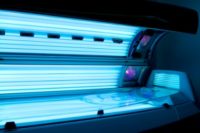 Skin cancer is the most common form of cancer in the United States. Get information about this potentially deadly cancer and what you can do to identify signs of skin cancer and decrease your risk factors.
Skin cancer is the most common form of cancer in the United States. Get information about this potentially deadly cancer and what you can do to identify signs of skin cancer and decrease your risk factors.
Risk Factors -- Anyone can get skin cancer, but sun exposure, family history, and certain medical conditions are among the risk factors.
Risk Factors
When you're told that you have skin cancer, it's natural to wonder what may have caused the disease. The main risk factor for skin cancer is exposure to sunlight (UV radiation), but there are also other risk factors. A risk factor is something that may increase the chance of getting a disease.
People with certain risk factors are more likely than others to develop skin cancer. Some risk factors vary for the different types of skin cancer.
Risks for Any Type of Skin Cancer
Studies have shown that the following are risk factors for the three most common types of skin cancer:
•Sunlight: Sunlight is a source of UV radiation. It's the most important risk factor for any type of skin cancer. The sun's rays cause skin damage that can lead to cancer.
•Severe, blistering sunburns: People who have had at least one severe, blistering sunburn are at increased risk of skin cancer. Although people who burn easily are more likely to have had sunburns as a child, sunburns during adulthood also increase the risk of skin cancer.
•Lifetime sun exposure: The total amount of sun exposure over a lifetime is a risk factor for skin cancer.
•Tanning: Although a tan slightly lowers the risk of sunburn, even people who tan well without sunburning have a higher risk of skin cancer because of more lifetime sun exposure. Sunlight can be reflected by sand, water, snow, ice, and pavement. The sun's rays can get through clouds, windshields, windows, and light clothing. In the United States, skin cancer is more common where the sun is strong. For example, more people in Texas than Minnesota get skin cancer. Also, the sun is stronger at higher elevations, such as in the mountains. Sunlamps and tanning booths: Artificial sources of UV radiation, such as sunlamps and tanning booths, can cause skin damage and skin cancer. Health care providers strongly encourage people, especially young people, to avoid using sunlamps and tanning booths. The risk of skin cancer is greatly increased by using sunlamps and tanning booths before age 30.
•Personal history: People who have had melanoma have an increased risk of developing other melanomas. Also, people who have had basal cell or squamous cell skin cancer have an increased risk of developing another skin cancer of any type.
•Family history: Melanoma sometimes runs in families. Having two or more close relatives (mother, father, sister, brother, or child) who have had this disease is a risk factor for developing melanoma. Other types of skin cancer also sometimes run in families. Rarely, members of a family will have an inherited disorder, such as xeroderma pigmentosum or nevoid basal cell carcinoma syndrome, that makes the skin more sensitive to the sun and increases the risk of skin cancer.
•Skin that burns easily: Having fair (pale) skin that burns in the sun easily, blue or gray eyes, red or blond hair, or many freckles increases the risk of skin cancer.
•Certain medical conditions or medicines: Medical conditions or medicines (such as some antibiotics, hormones, or antidepressants) that make your skin more sensitive to the sun increase the risk of skin cancer. Also, medical conditions or medicines that suppress the immune system increase the risk of skin cancer.
Other Risk Factors for Melanoma
The following risk factors increase the risk of melanoma:
•Dysplastic nevus: A dysplastic nevus is a type of mole that looks different from a common mole. A dysplastic nevus may be bigger than a common mole, and its color, surface, and border may be different. It's usually wider than a pea and may be longer than a peanut. A dysplastic nevus can have a mixture of several colors, from pink to dark brown. Usually, it's flat with a smooth, slightly scaly or pebbly surface, and it has an irregular edge that may fade into the surrounding skin.
A dysplastic nevus is more likely than a common mole to turn into cancer. However, most do not change into melanoma. A doctor will remove a dysplastic nevus if it looks like it might have changed into melanoma.
•More than 50 common moles: Usually, a common mole is smaller than a pea, has an even color (pink, tan, or brown), and is round or oval with a smooth surface. Having many common moles increases the risk of developing melanoma.
Other Risk Factors for Both Basal Cell and Squamous Cell Skin Cancers
The following risk factors increase the risk of basal cell and squamous cell skin cancers:
•Old scars, burns, ulcers, or areas of inflammation on the skin
•Exposure to arsenic at work
•Radiation therapy
Other Risk Factors for Squamous Cell Cancer
The risk of squamous cell skin cancer is increased by the following:
•Actinic keratosis: Actinic keratosis is a type of flat, scaly growth on the skin. It is most often found on areas exposed to the sun, especially the face and the backs of the hands. The growth may appear as a rough red or brown patch on the skin. It may also appear as cracking or peeling of the lower lip that does not heal. Without treatment, this scaly growth may turn into squamous cell skin cancer.
•HPV (human papillomavirus): Certain types of HPV can infect the skin and may increase the risk of squamous cell skin cancer. These HPVs are different from the HPV types that cause cervical cancer and other cancers in the female and male genital areas.
- Check Your Skin -- Doing regular self-exams will help you identify new growths or potentially harmful changes. See your doctor if you notice anything suspicious.
- Types of Skin Cancer -- Learn about the three most common forms of skin cancer and where on the body they tend to occur.
- Protect Your Skin -- If you limit your exposure to UV radiation in a variety of ways, you can decrease your risk of developing skin cancer.
- Avoid Tanning -- Too much exposure to UV rays through indoor or outdoor tanning can lead to skin cancer.
Source: USA.gov

